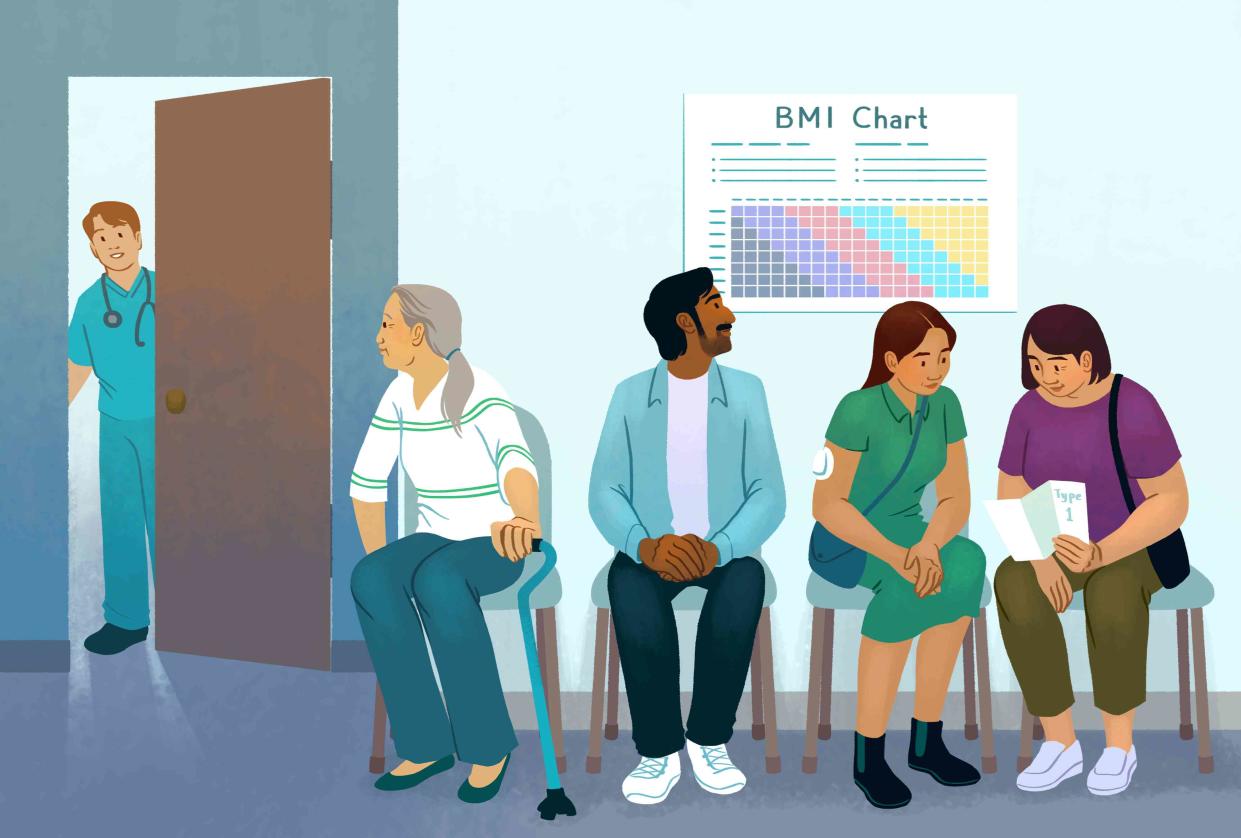BMI Can’t Predict Diabetes Risk for Asian Americans. What Else Might Work?

Illustration by Mira Norian for Verywell Health
Most health professionals use body mass index (BMI) to assess whether someone is at risk for health diseases like diabetes, however, this method may not be as accurate for Asian Americans due to their unique body composition.
Experts say Asian Americans tend to have higher fat distributions, more visceral fat, and lower muscle mass than other racial groups.
In addition to BMI, Asian Americans should consider other screening measures like waist circumference and blood pressure, and cholesterol levels when assessing their risk for diabetes.
Nearly 1 in 3 Asian Americans have diabetes but don’t know they have it.
Most healthcare providers use the body mass index (BMI)—a person’s weight divided by their height—as a way to assess diabetes risks. But the standard BMI measures may be unable to reflect diabetes and obesity risks in Asian Americans accurately.
Asian Americans tend to have higher fat distributions but lower muscle mass compared to other ethnic groups, and their body weight might be lower as a result, according to Caroline Ong, MD, MS, a cardiologist at Lenox Hill Hospital in New York.
“They may not look fat, but they have significant visceral fat, which is the fat that we are concerned about,” Ong told Verywell. “This fat is metabolically active and surrounds your heart, liver, and internal organs that you may not see. It also influences your insulin sensitivity and glucose intolerance and impacts your overall cardiometabolic health.”
Research shows that prediabetes and diabetes are prevalent in Asian populations even if their BMIs are within a healthy range—a BMI between 18.5 and 24.9. And using BMI as a broad indicator might also neglect important nuances among different ethnicities in Asian communities.
Related:Study: BMI Measurements Should Be Tailored To Race and Ethnicity
Why BMI Isn't a Good Measure for Asian American Health
There could be significant differences in fat and muscle distribution within diverse Asian ethnic groups, according to Ong. For example, Filipino and South Asian adults have considerably higher diabetes prevalence than Chinese adults, according to a 2022 study.
“The American Diabetic Society does have lower BMI recommendations for Asians. They lowered the BMI to 23,” Ong said. But this doesn't address the significant diversity among the Asian American populations, which include South Asian, East Asian, and Pacific Islander.
If health professionals fail to consider or overlook other risk factors specific to Asian Americans, it can lead to missed opportunities to screen for prediabetes or even a type 2 diabetes diagnosis, said Rose Lin, MD, an endocrinologist at Providence Saint John’s Health Center in Santa Monica, CA.
“If you look at somebody’s vitals and their BMI is not yet at 25, you may miss the opportunity to guide and counsel your patients on healthy changes that can prevent them from progressing or even developing type two diabetes,” Lin told Verywell.
Related:Researchers Say Waist-to-Hip Ratio Should Replace BMI—Here’s Why
What Are Some Good Alternative Measures?
Age
A recent study suggested screening for diabetes based on age—rather than weight—in order to detect cases of prediabetes and type 2 diabetes earlier in diverse populations.
While the current recommendation is to screen people who are overweight starting at age 35, screening for Asian Americans could start earlier at 35 regardless of their BMI or body weight, Lin said.
Waist Circumference
Another alternative to measuring diabetes in Asian populations is to use waist circumference or waist size, according to Ong. This measurement takes into account visceral fat that is deposited around the waist.
Women who have a waist size greater than 35 inches and men with a waist size of more than 40 inches are considered to be at higher risk of diabetes.
Related:The Importance of Waist Circumference
Blood Pressure and Cholesterol Levels
Blood pressure and cholesterol levels can also indicate diabetes, according to Megan Wong, RD, a registered dietitian at AlgaeCal who specializes in nutrition for chronic disease management and community health.
High blood pressure could be linked to insulin resistance and a greater risk of diabetes A 2020 study that evaluated 15,000 Chinese adults with high blood pressure showed that better control of blood pressure was associated with a lower risk of diabetes.
Low levels of HDL cholesterol—the "good" cholesterol—have also been associated with an increased risk of type 2 diabetes.
How Can Asian Americans Manage Diabetes Risks?
Ultimately, Asian Americans can't just assume they're free of diabetes risks just because "they maintain a lower body weight," according to Lin.
“If there’s a family history of diabetes or if an individual had gestational diabetes, then they should probably get screened even if there are no signs of being overweight or obese by conventional standards," Lin said.
A crucial consideration in managing diabetes in Asian Americans is diet, Wong said. Many dietary staples in the Asian diet consist primarily of simple carbohydrates, which can cause spikes in blood sugar.
“Figuring out how to modify the standard Asian diet to better manage blood sugar, while making sure meals remain enjoyable, is often a challenge,” Wong said.
However, “gradual changes can be helpful," she added. Staying active, managing stress, and avoiding smoking are also some of the ways to prevent diabetes.
Read Next:8 Sneaky Foods That Increase the Risk of Diabetes
Weight and BMI can be useful diabetes screening methods, however, they may not accurately reflect the risk for diabetes among Asian Americans and can lead to undiagnosed diabetes. In addition to BMI, experts recommend other alternatives to measure diabetes in Asian populations, which include using a lower BMI cutoff point, considering age, and using waist circumference.

